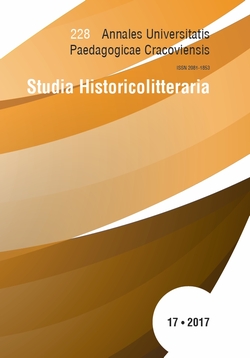Charles Swann e Athos Fadigati: la figura dell'ebreo e dell'innamorato in Proust e Bassani
Main Article Content
Abstrakt
Charles Swann i Athos Fadigati: postać Żyda i kochanka w utworach Prousta i Bassaniego
Streszczenie
Celem badań jest znalezienie związków pomiędzy cyklem Marcela Prousta W poszukiwaniustraconego czasu i Powieścią ferraryjską Giorgia Bassaniego. Analiza sposobu, w jaki autorzykonstruują postać Żyda, została przeprowadzona w świetle refleksji Giacoma Debenedettiegoi Hannah Arendt poświęconych naturze tożsamości żydowskiej. W opowiadaniu BassaniegoZłote okulary w szczególny sposób uczuciowość i pozycja społeczna homoseksualisty AthosaFadigatiego znajdują analogię w figurze Charlesa Swanna, ,,światowego Żyda”. W tej perspektywieProust staje się świadkiem zmiany, obserwatorem początku procesu prowadzącegodo powstania obozów zagłady, elementów rzeczywistości, z którą Bassani musi siękonfrontować.
Słowa kluczowe: Marcel Proust, Giorgio Bassani, Charles Swann, Żyd, kochanek, homoseksualista,sprawa Dreyfusa
Charles Swann and Athos Fadigati: the figure of the Jew and the lover in Proust and Bassani
Abstract
The aim of the research is to find a link between Recherche of Marcel Proust and GiorgioBassani’s Novel of Ferrara, analyzing the way both of them construct the figure of a Jew, inthe light of Giacomo Debenedetti’s and Hannah Arendt’s position related to Jewish identity.Giorgio Bassani’s novel The Gold Rimmed Spectacles has been chosen because Athos Fadigati,a homosexual, and Charles Swann, a Juif mondain, demonstrate some similarities in termsof sensitivity and their social position. Here Proust witnesses a change, the beginning ofa process leading to extermination camps: the reality Bassani must confront.
Keywords: Marcel Proust, Giorgio Bassani, Charles Swann, Jew, lover, homosexual, theDreyfus affair
Downloads
Article Details

Utwór dostępny jest na licencji Creative Commons Uznanie autorstwa – Użycie niekomercyjne – Bez utworów zależnych 4.0 Międzynarodowe.
POLITYKA PRAW AUTORSKICH
Wydawca „Annales Universitatis Paedagogicae Cracoviensis. Studia Historicolitteraria” jest upoważniony do korzystania oraz do rozpowszechniana wszystkich opublikowanych w czasopiśmie materiałów na podstawie umowy licencji niewyłącznej, zawartej uprzednio na czas nieoznaczony każdorazowo z autorem/ką konkretnego utworu na określonych w tamtejszej umowie polach eksploatacji.
POLITYKA OTWARTEGO DOSTĘPU
„Annales Universitatis Paedagogicae Cracoviensis. Studia Historicolitteraria” to czasopismo o otwartym dostępie, a cała jego zawartość jest dostępna bezpłatnie dla użytkowników i instytucji na zasadach licencji niewyłącznej CreativeCommons (CC BY-NC-ND 4.0). Użytkownicy/ki mogą czytać, pobierać, wykonywać kopie, rozpowszechniać, drukować, wyszukiwać lub linkować do pełnych tekstów artykułów w tym czasopiśmie bez uprzedniej zgody wydawcy lub autora/ki pod warunkiem podania źródła dostępu i autorstwa danej publikacji. Jest to zgodne z definicją otwartego dostępu BOAI (http://www.soros.org/openaccess).
Bibliografia
Arendt H., Le origini del totalitarismo, Torino 2009.
Bassani G., In risposta (V), [in:] Opere, Cotroneo R. (a c. di), Milano 1998, pp. 1317–1321.
Bassani G., Il romanzo di Ferrara, Milano 1980.
Borghesi A., La lotta con l’angelo: Giacomo Debenedetti critico letterario, Venezia 1989.
Brescia G., Bassani storicista e francesista (tra Croce e Proust, per tacer d’altri), «Osservatorio letterario» XIX/XX (107/108) 2015, pp. 88–91.
Camon F., Il mestiere di scrittore. Conversazioni critiche con Moravia, Pratolini, Bassani, Cassola, Pasolini, Volponi, Ottieri, Roversi, Calvino, Milano 1983.
Campeggiani I., Proust nell’opera di Bassani, «Chroniques italiennes» 23(2) 2012, pp. 1–29.
Debenedetti G., Rileggere Proust e altri saggi proustiani, Milano 2005.
Debenedetti G., 16 ottobre 1943, Torino 2015.
Deleuze G., Proust i znaki, Gdańsk 2000.
Dolfi A., Le forme del sentimento. Prosa e poesia in Giorgio Bassani, Padova 1981.
Forti M., Bassani romanziere fra memoria e storia, «Questioni» VII(1–2) 1959, pp. 58–64.
Hindus M., The Proustian Vision, New York 1954.
Marrus M.R., Hannah Arendt and the Dreyfus Affair, «New German Critique» 66, 1995, pp. 147–163.
Monette Ebert I., Le Premier Dreyfusard: Jewishness in Marcel Proust, «The French Review» 67(2) 1993, pp. 196–217.
Pasco A.H., The Color-keys to A la recherche du temps perdu, Genève 1976.
Proust M., Du côté de chez Swann, https://www.ebooksgratuits.com/, accesso: 16 XII 2017.
Sapegno N., Debenedetti, Torino e la cultura europea, [in:] Il Novecento di Debenedetti. Atti del Convegno, a c. di R. Tordi, Roma 1998, pp. 24–25.
Sonnenfeld A., Marcel Proust: Antisemite?, «The French Review» 62(2) 1998, pp. 275–282.
Ugniewska J., Miejsca utracone. Szkice o pamięci i zapomnieniu we współczesnej literaturze włoskiej, Warszawa 2014.
